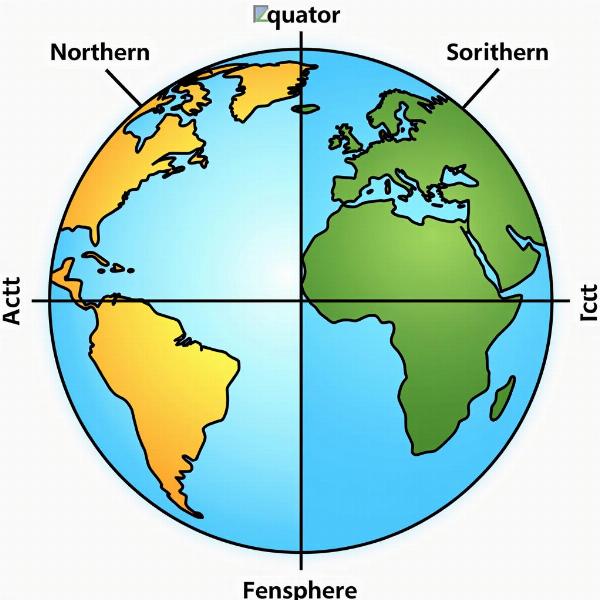Understanding the meaning of “hemis” is crucial for anyone studying geography, astronomy, or even just general knowledge. This word, derived from Greek, refers to half of a sphere, and its understanding opens doors to a deeper comprehension of various scientific and cultural concepts. “Hemis” meaning in Hindi is often translated as “ardh gola” (अर्ध गोला), literally meaning “half sphere.” This term accurately captures the essence of the word and is widely used in educational and scientific contexts.
Exploring the Different Hemispheres
The Earth, being a sphere, is divided into several hemispheres, each with its own unique characteristics. Let’s delve into some of the most prominent ones:
Northern and Southern Hemispheres
The most commonly known hemispheres are the Northern and Southern Hemispheres, divided by the Equator. The Northern Hemisphere contains North America, Europe, and most of Asia, while the Southern Hemisphere encompasses Australia, South America, and Antarctica. These hemispheres experience opposite seasons. When it’s summer in the Northern Hemisphere, it’s winter in the Southern Hemisphere, and vice-versa.
 Northern and Southern Hemispheres Divided by the Equator
Northern and Southern Hemispheres Divided by the Equator
Eastern and Western Hemispheres
The Earth can also be divided into Eastern and Western Hemispheres. While not as clearly defined as the North-South division, the Prime Meridian and the 180° meridian generally serve as the dividing lines. The Eastern Hemisphere includes Asia, Africa, Australia, and parts of Europe, while the Western Hemisphere includes North and South America and parts of western Europe. This division is essential for understanding time zones and global navigation.
Hemis in Astronomy and Other Contexts
The concept of hemispheres extends beyond Earth’s geography. In astronomy, we often refer to the celestial hemispheres, divided by the celestial equator. This division is crucial for locating and charting celestial objects. The term “hemis” also finds application in other fields like neurology, where we speak of the cerebral hemispheres of the brain, each controlling different functions.
How Does Understanding Hemispheres Help Us?
Understanding the concept of hemispheres helps us understand global weather patterns, seasonal changes, and the distribution of life on Earth. It’s also crucial for navigation, timekeeping, and understanding astronomical phenomena.
Hemis: Beyond the Basics
While “ardh gola” is a common and accurate translation, other terms like “golardh” (गोलार्ध) are also used. The nuances of these terms might be subtle, but they contribute to the richness of the Hindi language. Understanding these nuances can deepen your appreciation of the language and its ability to express complex scientific concepts.
Conclusion
“Hemis meaning in Hindi,” primarily translated as “ardh gola,” is a fundamental concept in various fields. Understanding this concept enriches our understanding of the world around us, from geography and astronomy to neurology and beyond. Whether you’re a student, a scientist, or simply curious about the world, grasping the meaning of “hemis” opens up a world of knowledge.
FAQ
- What is the most common Hindi translation for “hemis”? The most common translation is “ardh gola” (अर्ध गोला).
- What are the main hemispheres of the Earth? The Earth is primarily divided into Northern and Southern Hemispheres, and Eastern and Western Hemispheres.
- Why is it important to understand the concept of hemispheres? Understanding hemispheres is crucial for comprehending global phenomena like weather patterns, seasons, and navigation.
- Does the term “hemis” apply to anything other than Earth? Yes, “hemis” is used in astronomy to refer to celestial hemispheres and in neurology to describe the cerebral hemispheres of the brain.
- Are there other Hindi words used to describe a hemisphere? Yes, words like “golardh” (गोलार्ध) are also used, though less frequently.
- How do hemispheres influence seasons? The tilt of the Earth’s axis causes the Northern and Southern Hemispheres to receive varying amounts of sunlight throughout the year, leading to opposite seasons.
- How are hemispheres used in navigation? Hemispheres are used in conjunction with latitude and longitude to pinpoint locations on Earth.
Related Articles on Meaning-Hindi.in
- southern hemisphere meaning in hindi
- spontaneous meaning in hindi in chemistry
- concentrated meaning in hindi in chemistry
- rasayan meaning in hindi
Meaning-Hindi.in is your trusted partner for professional translation services between Hindi and various other languages. We specialize in business, legal, technical, website localization, and educational document translation. Our team of expert linguists ensures accurate and culturally sensitive translations, catering to diverse client needs. For high-quality, reliable translation services, contact us at [email protected] or call us at +91 11-4502-7584. Meaning-Hindi.in is your one-stop solution for all your translation needs.